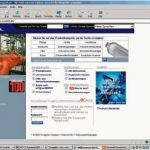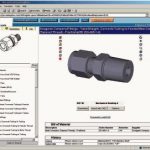CAD templates can be downloaded from a manufacturer’s web site and directly inserted into a CAD modelling program. An engineer uses this service 168 times a year on average. Swagelok, a prominent manufacturer of fluid system components, has therefore arranged its homepage accordingly.
Thomas Gubanc and Steve A. Sackett
Computer-aided design (CAD) has been an important tool for designers and engineers since the technology’s inception in the mid-1980s. Virtually all toolmakers, installers and integrators employ this technology to design and manipulate fluid systems assemblies. However, the last two years have brought the technology to an ever larger number of engineers with ever increasing speed. Today, CAD templates – either 2D or 3D – can be downloaded from a manufacturer’s web site or CD-ROM and directly inserted into any of the major CAD modelling programs (more than 80 in all), including AutoCAD, Mechanical Desktop, ProEngineer, Solid Edge and Solid Works. This technology makes CAD templates available to engineers directly and instantaneously at any time of the day. According to a survey commissioned by Thomas Register (www.cadregister.com), the number of CAD templates downloaded each year from all Internet sources has grown to over 10 million, with the average engineer downloading 168 drawings annually. One manufacturer’s web site, www.swagelok.com, has recorded strong growth in CAD template downloads, from about 8,000 per month in early 2001 to more than 25,000 at present (Fig. 1). While the largest number of CAD template downloads occur in North America, the technology is utilised throughout the world, with the biggest growth area in Asia. In China, the competition to provide CAD/CAM software packages to a hungry, expanding marketplace is particularly fierce.
Another Thomas Register survey cites that downloadable CAD templates save engi-neers as much as 204 hours a year. In 2000, engineers reported saving 12 hours per month through the use of downloadable CAD templates; this figure increased to 15 hours per month in 2001 and 17 hours in 2002. The same year, 87 % of engineers surveyed rated the impact of this technology on their organisation’s bottom line as either very significant (48 %) or somewhat significant (39 %).
From the standpoint of the manufacturer providing the downloadable CAD template, the technology is an important investment. About 75 % all CAD templates viewed and downloaded from the Internet are purchased and used in production. Sales directly linked to these downloads are estimated at more than 5.7 billion US$ per year, according to figures from one online CAD library alone.
Downloadable CAD templates are a valuable resource for the industry. System component manufacturers need to move swiftly to support greater availability, multiple formats and even multilingual access.
Search, research, downloading
Whether working from a CD-ROM or a web site, the process is much the same. In most cases, the engineer or designer knows what part they are looking for and which manufacturer makes it, which allows them to go straight to the right web site or CD-ROM. At this point, they could encounter the first difficulty in what is otherwise likely to be a smooth process. How deep should engineers have to dig before finding the part they are looking for? No more than three or four clicks, according to most engineers in the field. Ideally, the homepage should contain a clear listing of buttons identifying the general categories of products available. From these buttons, a few clicks should be sufficient for the user to identify the required specifications (Fig. 2). An alternative route often preferred is a search mechanism which allows the engi-neer or designer to enter a part name or number and receive a listing of all relevant matches.
Unfortunately, too many web sites today require the engineer or designer to sift through several layers of company information before getting to the products of interest. Confusing navigation is another common complaint. In a nutshell, engi-neers would like a direct, quick path to the product or CAD template they are seeking.
Sometimes, an engineer does not know which part they are searching for. Instead, they only know which function they would like it to perform. In this case, a web site or CD-ROM with an advanced search mechanism or calculator is helpful. Such mechanisms allow the user to enter specifications, such as the pressure range, temperature, specific gravity and Cv value, and receive a list of parts in return.
Once the desired part has been found on the web site or CD-ROM, accessing and downloading the CAD template is a simple matter of clicking on a button or two. The CAD template appears in three dimensions. In this form, the user can rotate it for examination and zoom in on particular features (Fig. 3). Then, if the part checks out, the engineer downloads it into the CAD modelling program.
Unresolved issues
While downloadable CAD templates are proving to be a very useful form of technology, there are some issues still to be resolved. How much information is sufficient in a CAD template, for example? How much is too much? Most information in a CAD is dimensional, i. e. the part’s overall measurements, inside and out. Critical to any design work in the semiconductor industry is space. Many engineers employ CAD templates for the purpose of testing configurations, to ensure that they can be contained within the desired footprint. In such cases, they may not want or need drawings that show details, such as the threads or handle. On the other hand, many engineers prefer the detail and never run into limitations with regard to file size. In their view, detail is integral, allowing them to take into consideration minute features such as the location of a screw. Engi-neers also weigh up questions concerning the appearance of the module in question. A tool may function as it is supposed to, but if it does not look good, it may not sell.
Given these competing requirements, there may be no such thing as the perfect downloadable CAD template, but manufacturers are called on to work with makers of downloadable CAD technology to communicate the needs of engineers and designers. It should be the goal of all component manufacturers to accommodate the varied requirements of individual toolmakers, OEMs and integrators, so that every engi-neer can obtain a CAD template appropriate to his or her uses directly from the Internet.
cpp 407
Share:









